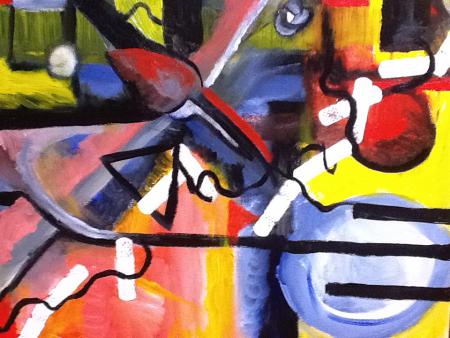Serendip is an independent site partnering with faculty at multiple colleges and universities around the world. Happy exploring!
Notes Towards Day 6 (Thurs, Feb. 2): Talking about Breaking!


Elizabeth Catanese, untitled, The Breaking Project: choosing radical change —
Breaking away, in, up, through, down, out, . . . ground, free . . . the cycle, the spell, the mold.
cf. froggie315, Break is Fake: Our thoughts have happened before.
There is no such thing as radical. There is no such thing as “break.”
Change and evolution, by their fundamental nature, are
S L O W, iterative, “tinkering” processes.
I. coursekeeping:
I'm looking forward to your first web events, due @ 8 p.m. this Friday
for Tuesday, please read Cathy Davidson and Theo Goldberg's "(In)conclusive: Thinking the Future of Digital Thinking." The Future of Thinking; Learning Institutions in a Digital Age. MIT Press, 2010. 175-199 -- in our password protected file (linked from top of the homepage); we'll spend part of class on that, part of it reflecting on what we learned from/might share re: our own web events (re-reading them through the lenses provided by all these theorists--and one another!). This will (nearly!) end the first section of the course, on the evolution of the genre of academic writing.
II. today we turn our attention to The Breaking Project,
founded by Alice Lesnick, who directs the
Bi-Co Ed Program, and who joins us today.
Alice is also experimenting w/ digital innovations in academic writing;
there's a link on the left, here, to her course on Literaries and Education,
where her students are (among other things!) using Twitter as a micro-blog,
pointing to other, longer posts of interest; next fall she'll do a course on
Education and Technology, which will expand on such experiments
(and maybe, the year after, we can co-teach that course?!)
See also much-related article in The Chronicle this week:
As Scholarship Goes Digital, Academics Seek New Ways to Measure Their Impact:
An approach called altmetrics—short for alternative metrics—
aims to measure Web-driven scholarly interactions, such as how
often research is tweeted, blogged about, or bookmarked ....
Scholarly workflows are moving online, leaving traces that can
be documented ... "It's like we have a fresh snowfall across this
docu-plain, and we have fresh footprints everywhere ... That has
the potential to really revolutionize how we measure impact" ....
It's a way to measure the "downstream use" of research.
III. go round, tell Alice who you are, and describe to
her something of your initial reaction to her "sourcebook."
She is designing an ESem in the fall using this text,
so would be especially glad for any feedback in that regard...
how might this work well in such a setting?
What questions or advice do you have for her, about using it that way?
IV. for Alice:
* how did you happen to come to do --and invite-- this kind of writing?
* what were you trying to do?
* what is it like, doing it? (emphasis on process)
* what sort of reception is it getting?
for us:
* what are all of our reactions, now, to this emerging web-work?
* how does it illustrate and/or challenge the various innovations of 21st c. web work
we've been reading about (Fitzpatrick on "Planned Obsolesence"; the
authors of the Digital Humanities Manifesto; Folsom and Stallybrass on
"remapping genre"; Letham on plagiarism; Aya, Jen, Cassie on their various projects...?)
V. The Breaking Project: Workbooking Dalke
The Genre Question!
What makes this text a “story in fragments” rather than an essay in fragments, or a life in fragments? Write an analytic response to this question in which you use ideas and terms from Dalke’s essay as thinking tools. In other words, what do you learn from and with Dalke about the nature of stories and what we tell them for?
Please post what you've written in the comment section @ the bottom of Dalke's story.....
w/ thanks!


